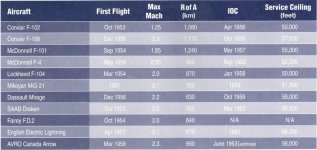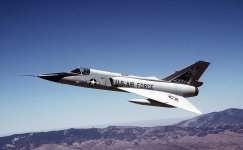And you can say that with a straight face?
Yup
While the Arrow probably deserved the accolades it received for expanding the envelope of aeronautical engineering, it was still just an aeroplane that was designed for a specific mission.
Most Jets were designed for a specific mission at the time and they evolved into multi roles as time and experiences happened.
There were lots of contemporary fighters being developed (and put into service before the Arrow was planned to actually get in production) that were also designed for the mission (and/or missions) of those other countries.
None of them could do what the Arrow did and in theory could do.
Can you honestly name one country that would have been so overawed by the brilliance of Avro Canada that they would have stopped development/production of their own fighter aircraft in order to buy Arrows?
Not saying they would have stopped development, but they would have bought the rights to build the Arrow and or variants.
Or can you envision Canada (even Canada of the 1950s) trying to be a major player in the international arms game?
Yes I can they were a major player during WWI and WWII. We still are in the pretty big in the tech game.
Or what second echelon countries would have been acceptable customers, in terms of financial resources or, more importantly, diplomatically acceptable? What features of the Arrow (if continuing development and testing have proven its excellence) would have made it so much more attractive than the other fighters already in the marketplace to probably a very limited customer base?
Compared to what was available then and for the next ten years or so the Avro was pretty darn good competition to any other program.
The fear of the US was having Canada build a better, faster Jet then they could. The overall program progression in a time when Faster was better.
The US government tanked that program for a reason. Shortly afterwards built some the best jets in the world. They were no where even close to design such as the Avro. It says a lot about their aerospace industry was stuck in a revolving door of subject matter experts who said no it cant be done and it wont be done. So it wasn't done.
Along came this Canadian company who said it could be done and they proved it could. Purely politics involved to squash the airplane. We had a better aerospace team, we had a better more precise environment to build with more freedom to experiment . They stepped on the big players in the US so they did what they do best. Figured out how to shut us down.
The US at the time had their doubts about Canada's loyalty also with our ties to the former USSR, that has been clearly documented on other other matters.
It sure would be interesting to see where the development would have gone had it not been scrapped.








